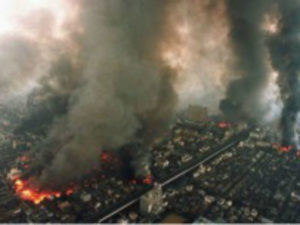A community is comprised of a complex and dynamic system of infrastructure and networks. The infrastructure serves the human needs and in an extreme event, ideally this infrastructure remains operable; but most infrastructure are not designed to resist low probability – high consequence events. In addition, the functionality of infrastructure such as buildings and bridges are typically studied in isolation, meaning it does not consider how they interact with – and depend on – networks such as water, power, and transportation. This new line of research examines the functionality of buildings following an extreme event considering the interdependencies of various networks as well as building structural response. In particular a fire following earthquake scenario is evaluated for an urban community. As a first step, we have developed a probabilistic fire ignition model based on historical data that can be implemented in an open source GIS-based software (Ergo/Maevis). In addition, fire fragility functions are being developed for a suite of building typologies.
Partial List of References
- Coar, M., Sarreshtehdari, A., Garlock, M.E.M., Elhami Khorasani, N. (20xx). “Methodology and challenges of fire following earthquake analysis: an urban community study considering water and transportation networks”, Natural Hazards, Springer Publishers, https://doi.org/10.1007/s11069-021-04795-6
- Coar, M., Garlock, M.E.M., Elhami Khorasani, N. (2019). “Effects of water network dependency on the electric network for post-earthquake fire suppression”, Sustainable and Resilient Infrastructure, Taylor and Francis, Published online: 12 Feb 2019, https://doi.org/10.1080/23789689.2018.1563408
- Gernay, T., Elhami Khorasani, N., Garlock, M.E.M. (2018).””Fire fragility functions for steel frame buildings: Sensitivity analysis and reliability framework”, Fire Technology, Springer, p. 1-36.
- Elhami Khorasani, N., Garlock, M.E.M. (2017). “Overview of Fire Following Earthquake: Historical Events and Community Responses” International Journal of Disaster Resilience in the Built Environment, Volume 8, Issue 2.
- Elhami Khorasani, N., Gernay, T., Garlock, M.E.M. (2017). “Data-Driven Probabilistic Post-Earthquake Fire Ignition Model for a Community”, Fire Safety Journal, Elsevier, Vol 94, pp. 33-44.
- Coar, M., Elhami Khorasani N., Garlock M.E.M. (2016). “Integrating Water And Electric Systems In Post-Earthquake Fire Analysis”, Proceedings of International Symposium on Sustainability and Resiliency of Infrastructure, Taipei, Taiwan, November 9-12.
- Gernay, T., Elhami Khorasani, N., Garlock, M.E.M. (2016). “Fire fragility curves for steel buildings in a community context: a methodology.” Engineering Structures, Elsevier, Volume 113, 15 April, Pages 259–276.
- Olsen, M.J., Cheung, K.F., YamazakI, Y., Butcher, S., Garlock, M., Yim, S., McGarity, S., Robertson, I., Burgos, L., and Young, Y.L. (2012). “Damage Assessment of the 2010 Chile Earthquake and Tsunami Using Terrestrial Laser Scanning”, Earthquake Spectra, Vol. 28, No. S1, pp. S179-S197
- Neal, M., Garlock, M.E.M., Quiel, S.E., Marjanishvili, S. (2012). “Effects of Fire on a Tall Steel Building Designed to Resist Progressive Collapse”, Proceedings of the ASCE Structures Congress, ASCE, Chicago, March.

